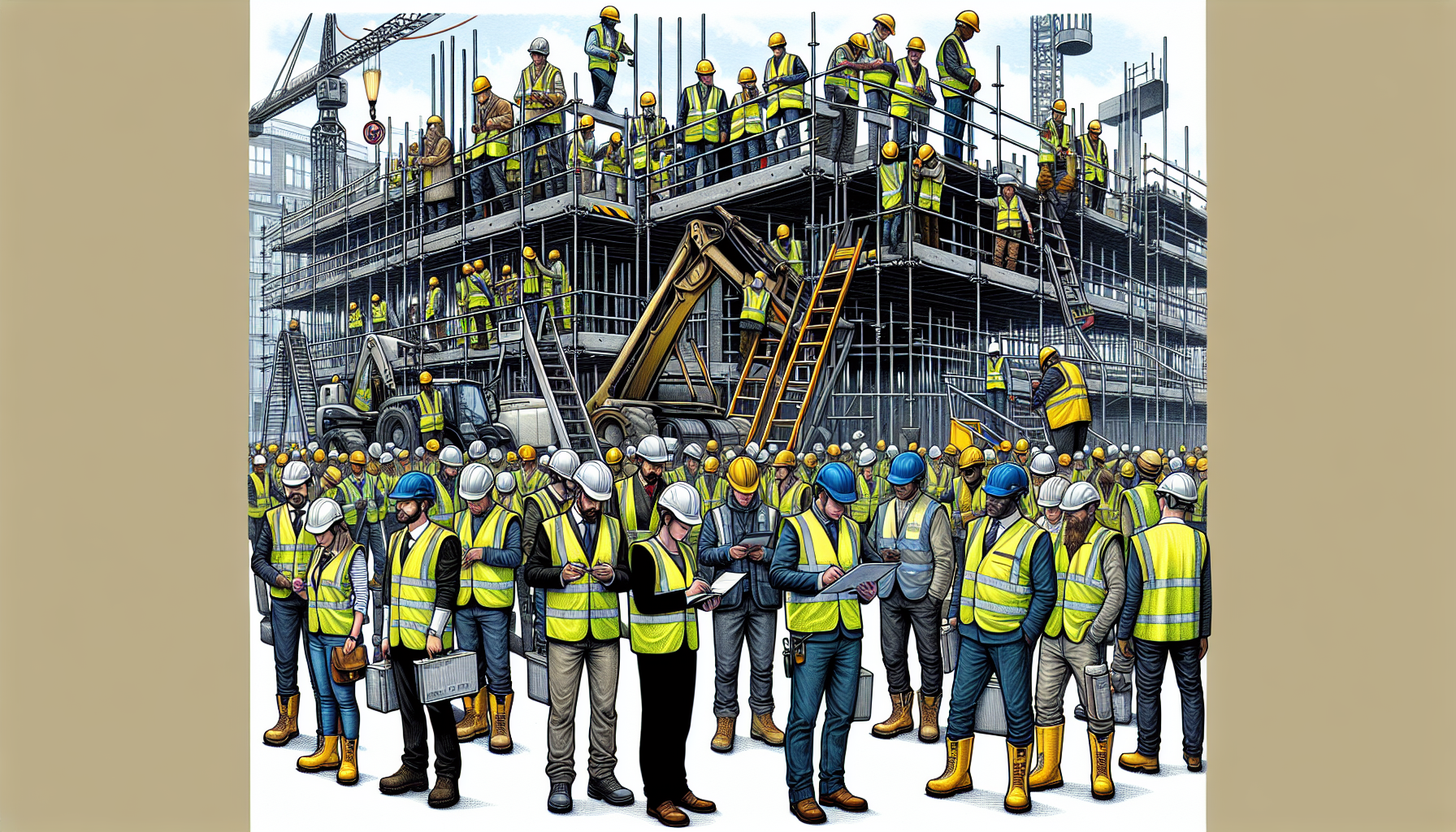Construction reporting is the systematic documentation and communication of vital information within a construction project. Its key purpose is to provide stakeholders with transparent, timely, and accurate data about the project’s progress, budget, and compliance with regulations. Examples of vital documents used in construction reporting include the construction incident report, which documents any incidents on-site to identify causes and prevent recurrences, and the construction safety report, which tracks site safety, equipment usage, and potential hazards. This article delves into the strategies for maximizing efficiency in construction reporting and explores the benefits it brings to managing complex projects effectively.
Table of Contents
Key Takeaways
Construction reporting is vital for monitoring project progress, managing costs, and ensuring transparency, with reports being most effective when clear, concise, and void of unnecessary duplication.
Reports serve multiple key roles, including maintaining project transparency, aiding communication among stakeholders, managing risk, and documenting audit trails to support operational efficiency and accountability.
Effective construction reporting involves implementing standardized templates, utilizing digital tools for real-time updates and collaboration, and prioritizing data accuracy and timeliness to improve project outcomes.
Construction reports are crucial for managing various aspects of the construction site, including safety, budget, and workflow.
Understanding Construction Reporting

Construction reports act as a fundamental component in the management of construction projects by providing a critical means to oversee progress, manage expenses, and uphold clear communication among all parties involved. These formal documents are designed to capture important milestones, phases of work, and other significant activities within the project’s scope in an organized and accessible manner for stakeholders. The significance of such reporting lies in its ability to boost operational effectiveness through vigilant tracking of how the project unfolds along with enhancing efficiency on-site by recording daily operations while also pinpointing areas that may require attention.
The importance of construction reports is evident throughout every phase from preconstruction planning to final handover. They maintain key roles by facilitating uninterrupted oversight over the entire span of a project’s timeline. Noteworthy for their precision and succinctness, these reports focus on delivering crucial data without redundant content which aids those managing projects with informed decision-making processes—they present an accurate depiction capturing where exactly a construction initiative stands at any point in time. Construction reports are essential for managing on-site activities at the construction site, ensuring safety, and connecting the site to the office through real-time dashboards and mobile app features.
The Critical Role of Construction Reports

Construction reports serve pivotal purposes, one of which is to ensure transparency. They offer comprehensive accounts of actions taken and decisions made, thereby promoting accountability within the project framework and assuring that every stakeholder possesses a definitive understanding of the project’s progress.
These reports are instrumental in risk management. By enabling prompt detection of impending risks and offering comparative perspectives on projected versus actual expenditures, they empower the project team to proactively tackle problems before they amplify. Construction reports provide valuable audit trails which underpin operational efficacy and integrity by allowing for a retrospective examination of what transpired during each phase of the project, fostering trust through open disclosure.
Delving into Different Types of Construction Reports

There exists an array of construction reports designed to support the multitude of activities and operations within a construction project. These reports each fulfill unique functions, from recording daily on-site occurrences to keeping tabs on the advancement of the project, as well as overseeing financial expenditures related to it. Examples include the construction safety report, which tracks site safety, and the construction incident report, which documents any incidents that occur on-site.
We will delve into these different categories of report types.
Daily Reports: Capturing Day-to-Day Operations
Daily reports are a key component of the construction reporting process, recording various aspects of the day’s events on the construction site. These aspects include:
The arrival of visitors
Receipt of deliveries
Workforce presence
…as well as any issues that may arise during operations.
It is vital to integrate weather reports into this documentation since temperature fluctuations, precipitation levels, and wind velocities can greatly influence both current activities and future scheduling in construction projects.
The responsibility for maintaining these daily logs falls upon site supervisors. Tasked with monitoring everyday activities at the job site, they ensure data accuracy within these documents. Their meticulous oversight provides a trustworthy account regarding the ongoing workings at a construction location.
Progress Reports: Monitoring the Project’s Timeline
Construction progress reports are essential components of construction projects, serving to maintain clear communication between contractors and all stakeholders about the project’s progress and documenting the present stage of the project as well as outlining outstanding tasks. These informative documents benefit from timeline templates specifically designed for construction projects, which streamline task organization, track project evolution, and flag potential risks before they escalate.
Detailed work-in-progress reports or simply progress reports provide an in-depth look at continuous activities within a project. They offer a complete picture of how the entire endeavor is advancing by tracking individual trades and sections meticulously. This ensures that every aspect is considered and concluded according to schedule.
Cost Reports: Keeping a Pulse on Financial Health
Detailed cost reports are an essential element in the realm of construction reporting. These cost reports offer comprehensive financial insights about a project, including specifics on material consumption, hours worked by laborers, and various incurred costs. These documents are prepared at regular intervals to shed light on expenditure details, deviations from the set budget, and provide a snapshot of the project’s financial status.
The projection team utilizes job costing forecasts to evaluate prospective expenses associated with workforce deployment, raw materials usage, and general overheads for establishing projections related to profitability as well as budgeting considerations. Such estimates take into consideration both market demands and potential shifts in pricing, thereby ensuring more effective planning through precise predictions concerning necessary quantities and expenditures tied to resources.
Maintaining accuracy when it comes time for data collection is paramount. This ensures improved command over fiscal allocations within projects. It also helps circumvent errors that lead either to overspending or underfunding – always aiming towards optimal alignment of funds according to established requirements guiding the endeavors undertaken by teams involved.
Best Practices for Effective Construction Reporting

Understanding the different types of construction reports is as crucial as mastering their creation and management. Accurate reporting on the construction site is essential for effective project management. To enhance construction reporting, it’s important to adopt standardized templates, utilize digital tools for report generation, and ensure the data’s accuracy and promptness are given top priority.
Implementing Standardized Templates
Standardized templates play a crucial role in optimizing the reporting process within construction projects. They help minimize inconsistencies and promote uniformity, which aids significantly in analyzing data for informed decision-making and improves time management.
The adoption of these standardized report formats boosts efficiency in reporting activities, curtails disparities between various project stakeholders, and guarantees that all parties involved are aligned. This alignment is instrumental in enhancing cooperation among stakeholders and ultimately leads to improved results for the project.
Embracing Digital Reporting Tools
Adopting digital tools for construction reporting can significantly enhance the productivity and precision of this practice. Digitizing these reports transforms the way information is shared, creating a more cooperative and available system that improves engagement and immediate access for everyone involved.
Through real-time updates provided by digital reporting methods, project managers as well as other stakeholders are empowered to make timely informed decisions drawing on up-to-the-minute data such as images and video recordings documenting site advancements. Automated gathering of data coupled with assistance from technology in the reporting workflow decreases mistakes while boosting the reliability of construction reports so that they accurately depict present circumstances and occurrences at the site.
Prioritizing Data Accuracy and Timeliness
It is crucial for the efficacy of construction reporting that data is both accurate and promptly delivered. Having reliable information provides a solid groundwork for transparency, regulatory compliance, and an in-depth grasp of the various project aspects, all necessary for making informed decisions. Project managers need up-to-date data to swiftly pinpoint potential risks and take actions grounded in the latest understanding of where projects stand.
The backbone of robust project management lies within well-executed construction reports which focus on:
The precision and promptness with which information is presented
Employing digital tools to elevate accuracy as well as lucidity in reports while minimizing errors made by humans
Offering definitive proof when settling disputes becomes necessary
Streamlining Communication with Construction Reports
Construction reports play a vital role in ensuring seamless communication across the various parties involved in a construction project. Establishing an effective chain of command is integral to guarantee that messages are delivered promptly and accurately to the appropriate individuals. The importance of maintaining structured communication protocols and thorough documentation within construction projects cannot be overstated, as they help prevent confusion and keep timelines intact.
To circumvent any potential misunderstandings and sustain professionalism on site, it’s imperative to engage in clear written exchanges through construction reports. Such reporting enhances team cohesion by enabling information flow among those engaged in the project. It is through active listening along with regular provision of feedback within these interactions that mutual comprehension can be achieved. Underscoring its significance for productive communication dynamics within construction sites.
The fundamental purpose behind providing detailed construction reports lies at their ability to present transparent insights into task requirements expected from onsite crews—highlighting why meticulousness in constructing such updates proves crucial for successful project execution.
Reporting for Safety and Compliance

In the context of construction reporting, safety and compliance documentation, including the construction safety report, plays a crucial role. These documents are essential for recording incidents on-site, providing legal safeguarding for both workers and their employers, as well as ensuring that site safety is upheld consistently. The responsibilities of the safety personnel include:
Establishing and executing onsite safe practices
Ensuring adherence to established protocols regarding safety
Keeping the working conditions hazard-free
Fulfillment of statutory obligations
All these important activities find their record in a thorough construction report focused on site safety.
Enhanced risk management along with bettered security measures at construction locations can be achieved through software tools designed specifically for inspection reports as well as standardized forms. Such technological aids play an instrumental part in pinpointing possible dangers early enough so they can be mitigated promptly. A key element in avoiding mishaps and preventing harm lies within unwavering compliance with all prescribed health guidelines—where obtaining building permits acts not merely as a formality but significantly enforces critical precautions pertaining to worker protection.
Analyzing Trends with Construction Reports
Reports on construction trends serve as essential tools for forecasting developments within the industry. By projecting financial needs for forthcoming ventures, such as the expenses related to renovations or constructing new homes, these reports facilitate strategic decisions and fiscal foresight.
Such reports provide current information concerning various categories of building construction and scrutinize their market viability and competitive standing. The synthesis and examination of data from diverse forms of construction activities enhance strategic decision-making through the insights obtained from these trend analyses.
Financial Insights through Construction Reports
Gleaning financial insights from construction cost reports is pivotal for the effective management of a construction project. Such reports meticulously outline diverse cost categories including direct, indirect, fixed, and variable costs.
The groundwork these reports lay is indispensable for formulating precise budgets, maintaining control over expenditures, and steering fiscal strategy.
Costs are delineated in depth within cost reports through critical components like the initial budgeting figures alongside any approved or still-pending change orders as well as projections up to completion. This contributes significantly to sharpened financial oversight throughout the duration of a project’s existence. The essence of successful cash flow management hinges on collecting data that is both contemporary and accurate — vital not only for planning financially against unforeseen events but also ensuring adherence to established timelines with minimal interruptions.
In-depth analysis embedded in detailed cost reporting provides exhaustive documentation which facilitates an unobstructed perspective on expenses already borne while equally equipping managers with predictive insights about potential future outlays.
Navigating Challenges in the Reporting Process
The process of reporting in construction is essential to the success of a project, yet it often faces several obstacles that can impede effectiveness. These issues may encompass:
The presence of erroneous data
A shortage in the accessibility of data
Inconsistencies within collected data sets
An absence of uniform systems for capturing standardized information
Challenges in keeping cost reports both accurate and consistent
To overcome these hurdles, introducing orderly methods and applying automated tools are key strategies for preserving the accuracy of data and overseeing financial aspects with precision. Automation also removes much manual effort linked to report generation, thus enhancing efficiency which helps ensure that reports are generated on time.
Crucial too is collaboration among stakeholders involved in the reporting process. Each stakeholder contributes distinctly but synergistically towards ensuring high-quality management practices when handling project-specific information.
Transforming Reporting with Technology
Technological advancements have brought about substantial changes in the realm of construction reporting. By enhancing coordination among field teams and paving the way for a less error-prone sector, digital construction reporting has revolutionized the way we manage construction projects. Tools like Proest have been instrumental in saving resources and streamlining reporting processes.
Specialized software solutions, such as Slingshot, help organize construction workflows and projects, facilitating:
Clear communication
Consolidated data tracking
Real-time data and automated processes
Accurate construction forecasting
Integration with project management systems
Enhanced project collaboration
These technologies optimize project outcomes by providing a single source of truth and improving project collaboration for the project manager.
Summary
To summarize, construction reports play an essential role in project management by providing key information on the performance of a project, its financial stability, and adherence to safety standards. These reports improve communication channels, increase transparency among stakeholders, and support more informed decision-making processes. Through the adoption of modern technologies and adhering to established best practices for their creation and use, these documents can greatly boost the success rate of construction projects.
Frequently Asked Questions
What is reporting in construction?
Within the construction industry, generating construction reports is a fundamental task that involves creating formal records to convey significant occurrences, stages of development, and procedural details to all parties involved in the construction project. These essential documents serve both as communication tools and archival records for various aspects of the project’s progress or its financial health and are typically presented in written form.
For these reports on a construction project to be truly effective, they must adhere to certain standards including:
Being concise
Clarity in language
Easy navigability
Inclusion of solely pertinent information so as not to repeat content
The accuracy and promptness of such reporting play an instrumental role in providing teams with clear insight into their expected duties. Conversely, inaccurate reporting can have severe repercussions on both timelines and fiscal plans associated with the project.
What is a construction report?
A construction report serves as a comprehensive overview of project data, designed in an accessible manner to aid decision-making and enhance the clarity and efficiency for everyone involved. It meticulously records each phase of a project by chronicling adjustments to plans, finished tasks, and related expenses to maintain informed stakeholders.
The evolution of modern construction reporting has moved away from lengthy narrative formats toward condensed digital dashboards that incorporate engaging graphics such as charts and graphs which facilitate strategic planning. Construction reports act as benchmarks for:
Grasping the essence of projects
Detecting emerging patterns
Predicting potential setbacks
Tracking current progress
Why is construction reporting important?
Reporting in construction is critical as it improves operational effectiveness, ensures clarity, assists in managing risks, and supports robust communication between all parties involved.
Such reporting practices promote continuous advancement and responsibility within construction projects.
What are the different types of construction reports?
Different types of construction reports, including daily reports, progress reports, cost reports, and safety reports, each provide in-depth details specific to various segments of a construction project.
How has technology transformed construction reporting?
By simplifying procedures, bolstering coordination efforts, offering instantaneous data refreshes, and maintaining secure management of information, technology has revolutionized reporting in the construction sector. This advancement has resulted in heightened efficiency and precision within report generation.
Related posts
Read our other articles where you can find useful and relevant information about construction reporting:
- Construction Progress Reporting: Your Comprehensive Guide to Improved Project Tracking
- Top Strategies for Effective Construction Daily Reporting
About the Author

Taavi Kaiv
Taavi Kaiv is a construction specialist with over ten years of experience in the construction industry. Taavi is an accomplished construction project manager with many successful projects that have been completed under his guidance. Taavi holds a master’s degree in construction management from the Tallinn University of Technology. View profile






